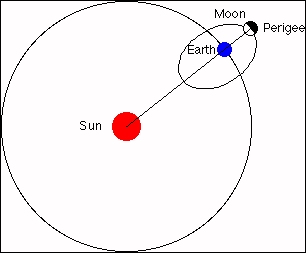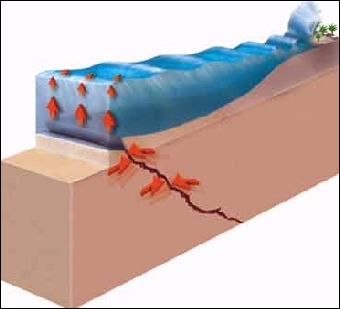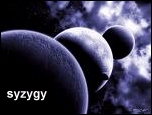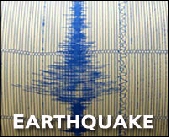Richard Nolle
2010's Eclipses and
SuperMoons
NeptuneCafe presents
advertisements
SuperMoons are noteworthy for their close association with extreme tidal forces working in what astrologers of old used to call the sublunary world: the atmosphere, crust and oceans of our home planet - including ourselves, of course. From extreme coastal tides to severe storms to powerful earthquakes and volcanic eruptions, the entire natural world surges and spasms under the sway of the SuperMoon alignment - within three days either way of the exact syzygy, as a general rule. SuperMoon solar eclipses tend to have a wider sphere of impact, extending roughly a week before and after the actual event. And other lunar extremes (of declination, for example) can extend the geocosmic stress window by a day or two here and there in any case.
2010 World Forecast
Obviously it won't be the case that all hell will break loose all over the world within a few days either side of the SuperMoons of 2010. For most of us, the geocosmic risk raised by SuperMoon alignments will pass with little notice in our immediate vicinity. This is a rather roomy planet, after all. But the fact remains that a SuperMoon is planetary in scale, being a special alignment of Earth, Sun and Moon. It's likewise planetary in scope, in the sense that there's no place on Earth not subject to the tidal force of the perigee-syzygy.
A simple review of the news over the past few years should serve to get you acquainted. Take Hurricane Katrina, for example; spawned from a tropical depression formed within three days of the August 19 SuperMoon. My forecast for 2005 warned of severe storms within plus or minus three days of the day Hurricane Katrina formed, and even specified the Gulf of Mexico as one of the areas at risk in connection with that particular SuperMoon alignment.
Examples of the SuperMoon connection with major storms and seismic events abound: the Mt. Pinatubo eruption, the largest volcanic event in the second half of the 20th Century, took place on June 15, 1991 (within three days of a SuperMoon); the October 6, 1948 Richter 7.3 earthquake that struck Ashgabat, Turkmenistan and took 110,000 lives, one of the deadliest earthquakes on record (again within three days of a SuperMoon, allowing for time zones); and the September 8, 1900 hurricane and tidal surge that struck Galveston, Texas on the day of a SuperMoon, which killed more people (8,000 dead) than any other Atlantic hurricane on record and remains the deadliest natural disaster yet to strike the United States. I'm just scratching the surface here, citing only a few historic instances in the past hundred years or so. Look a little deeper, and you'll run across literally hundreds more greater and lesser seismic and meteorological disturbances, from Hurricane Andrew in 1992 to the 1989 World Series (Loma Prieta) earthquake - just to name a couple contemporary notable examples.
The 2010 SuperMoons
First comes the full moon on January 30 at 10° 14’ Leo, followed by the February 28 full moon at 9° 58' Virgo). After a hiatus of several months, the SuperMoon train resumes with a trio of new moons starting with the one at 17° 25’ Leo on August 10, followed by the September 8 new moon at 15° 40’ Virgo, and then the one at 14° 24 Libra on October 7. (There won’t be another SuperMoon until February 18, 2011.)
The first SuperMoon of 2010 falls on January 30 at 10° 15’ Leo, when the full moon aligns with Mars in the sky (and Venus with the Sun). It’s also particularly potent, for a couple of reasons: it’s the closest SuperMoon of the year, and it occurs within just a few hours of the Moon’s northward crossing of the celestial equator. Expect a full litany of SuperMoon phenomena from January 25 through February 2: an increase in coastal flooding due to higher than usual tides, a gaggle of strong storms with high winds and heavy precipitation (triggering inland flooding), and of course an up-tick in moderate to severe seismic activity (including magnitude 5+ earthquakes as well as volcanic eruptions).
The February 28 SuperMoon full moon at 9° 59' Virgo is an exception to the Mars-Venus theme this year, but it’s in the midst of the Red Planet’s close approach to Earth nonetheless. Consequently, I’m still expecting more than the usual rasher of rash behavior in February – just not tied so closely in time to this particular full moon. What I do expect is a newsworthy upsurge in moderate-to-severe seismic activity (including magnitude 5+ earthquakes and volcanic eruptions), plus strong storms with damaging winds and heavy precipitation; along with extreme high tides. In effect from February 25 through March 3, and happening within sixteen hours of the Moon’s southward crossing of the celestial equator, this looks mostly like a storm and flood indicator – probably not on a par the January alignment, but noteworthy in its own right.
After a six-month lapse, a train of three SuperMoon new moons starts with the alignment at 17° 25’ Leo on August 10. (Venus and Mars are conjunct for this alignment.) This one has a wide effective geocosmic shock window, beginning on August 5 as the Moon’s north declination peak approaches; and continuing into the 13th. Expect the usual: strong storms with high winds and heavy precipitation, unusual tidal surges, and of course a raft of magnitude 5 quakes and volcanic eruptions.
Next up is the September 8 SuperMoon at 15° 41’ Virgo, just a few hours before the Moon crosses the celestial equator from north to south – and with another Venus-Mars conjunction in effect, along with the Great T-Square. Expect the usual, during the geophysical stress window that runs from the 5th through the 11th: an upsurge in extreme tidal surges, severe storms and moderate-to-severe seismic activity (including magnitude 5+ earthquakes and volcanic eruptions). No place on earth is beyond the reach of at least one such disturbance.
Finally comes the October 7 SuperMoon new moon at 14° 24’ Libra (conjunct Saturn), still with the Venus-Mars conjunction and also hard on the heels of the Moon’s southward equatorial crossing. The Venus-Mars connection again points to inflamed passions, manifesting anywhere along the spectrum from the lust and avarice of individuals to deadly violence both individually and collectively. We’ll all be glad when this one’s over. In effect from the 4th through the 10th, the October SuperMoon has a strong storm and seismic connection, so look for events of this sort to make more than the usual number of headlines worldwide.
The 2010 Eclipses
There are four eclipses this year, an average number. They’re transitioning from the Cancer-Capricorn polarity (where the first three occur) into the Gemini-Sagittarius polarity. In the process, they line up with Pluto, which spends the latter part of the year aligned with the Moon’s north node – a sign of crop failure, hunger and privation; and of the powers that be doing whatever it takes, however brutal, to stay in control for as long as they can.
The January 15 annular solar eclipse at 25° 01’ Capricorn is conjunct Venus, at a time when Mercury aligns with Pluto and Jupiter with Neptune, and very near the peak of the Mars Max cycle.... Being a solar eclipse, this one has an effective shock window that runs from the 8th through the 22nd, in terms of its connection with disturbances in the skies, seas and crust of our home planet. (Significant storms and seismic activity are likely.)
The June 26 partial lunar eclipse signals what may be the most dramatic period of the whole year. It falls in the midst of the Great T-Square of 2010, and turns it into a Grand Cross: the full moon conjunct Pluto squaring the Jupiter-Saturn opposition and Jupiter conjunct Uranus. This may be the cosmic trigger for the turning point represented by the Great T-Square. Business as usual is the last thing anyone will be thinking about at a time like this.
July 11 brings the year’s second total solar eclipse, which falls at 19° 23’ Cancer – at a time when the Great T-Square of 2010 is still very close to exact, which suggests more turbulence in the socio-economic and political arena will break out in early to mid-July. (By the same token, desperate times call for desperate measures, and this eclipse is bound to usher in some attempts at corrective action.) The July 11 total solar eclipse belongs to Saros Cycle 146, which began in 1541 – at a time of Islamic expansion into Europe that saw Muslim armies take Hungary. A very wide geocosmic stress window goes with this eclipse, stretching all the way from the 1st (in advance of the Moon’s northward crossing of the celestial equator) all the way through the 18th. This is another extreme lunation, coming just 48 hours after the lunar south declination maximum. Consequently, look for headline-making powerful storms and moderate-to-severe seismic activity (e.g. magnitude 5+ quakes and volcanic eruptions) during the indicated stress cycle.
The last eclipse of the year occurs on December 21, and belongs to Saros 125, which began in 1163. It’s a total lunar eclipse at 29° 20 Gemini, with the Sun at that time in a rolling conjunction including Mercury, Pluto and Mars. The Great T-Square by this time has broken up: we’ve hit the bottom of the latest economic hole, and are digging our way out. The “W-shaped” recovery has turned the corner – this time, I think for good. Well, not forever, because the business cycle and bubble mentality are too deeply engrained in nature and human nature for that. And not fast either, because it takes until 2020 at least for the New World Order to get up to speed. But the December 21 eclipse does look like a turning point . . . It also looks like a time for a new round of storm and seismic headlines.
What is a SuperMoon?
I mentioned at the outset that this year’s extreme declination SuperMoons look like an important theme for 2010. SuperMoon is a word I coined in a 1979 article for Dell Publishing Company's HOROSCOPE magazine, describing what is technically termed a perigee-syzygy; i.e. a new or full moon (syzygy) which occurs with the Moon at or near (within 90% of) its closest approach to Earth (perigee) in a given orbit. In short, Earth, Moon and Sun are all in a line, with Moon in its nearest approach to Earth.
Of course, earthquakes and volcanic eruptions don't go wandering all over the planet. They happen in predictable locations, like the infamous "Ring of Fire" around the Pacific plate. If you're in (or plan to be in) a place that's
subject to seismic upheaval during a SuperMoon stress window, it's not hard to figure out that being prepared to the extent that you can is not a bad idea. Likewise, people on the coast should be prepared for extreme tidal surges. Severe storms on the other hand can strike just about anywhere, so it behooves us all to be ready for rough weather when a SuperMoon alignment forms.
Like eclipses, there are typically four or five SuperMoons annually. We get five this year. (There’s not another year that gets short shrift in SuperMoons until 2013, which has only three.) All of the 2010 SuperMoons are closely associated with another extreme lunar factor: the Moon’s crossing of the celestial equator (the plane of Earth’s equator, projected out into space). This close association between the lunar perigee and the lunar equatorial crossing is something that slips in and out of synch. The two have been meshing within a couple days of each other from summer into fall of 2009, a period of notable storm and seismic activity.
Don’t get me wrong, 2010 doesn’t shape up to be one of those geophysical disaster years like 2005-2007, when the Moon reached the apex of its 18.6-year declination cycle – the so-called lunar standstill. Maximum lunar declinations were running in excess of 28º back in 2005-2006. For 2010, the peaks are down into the 25º range. Extreme lunar declination years tend to have extreme storms and seismic activity. Think Hurricane Katrina, the December 2004 Sumatran earthquake and monster tsunami: these natural disasters accompanied the most recent peak in the lunar declination cycle.
We’re well away from those high declinations and associated risks this year, but having a string of SuperMoons each very near the monthly lunar equatorial crossing is a combination that enhances the prospects for geophysical extremes – even more than an ordinary SuperMoon, which is in its own right a harbinger of enhanced disturbances in the skies, seas and crust of our home planet. I’m not expecting a Katrina or Sumatra class year of hurricanes or seismic activity in 2010, but I do anticipate a more than usual level of major storms, quakes and volcanic eruptions associated with this year’s SuperMoons and eclipses.
Richard Nolle is a graduate of the University of Florida. He holds the Professional Certificate of Proficiency in Natal Astrology from the American Federation of Astrologers. In 30+ years of practice, Nolle has counseled thousands of clients. He's the author of four books, and a
The material on this page is excerpted from Richard Nolle's
2010 WORLD FORECAST
It's especially relevant now since it was written in December 2009, and is an excellent explanation of why we've had two devastating earthquakes (so far).
Read the entire 2010 forecast: World Forecast Highlights
columnist and feature writer for Dell Publishing Company's HOROSCOPE magazine from 1975 to 1992. Nolle's work has been published in all the top U.S. astrology magazines and in the interdisciplinary scientific journal Cycles. Visit his website astropro. Additional info is on his Facebook profile
Advertise on this site. For more info, email wolfstar3@aol.com
"I do anticipate a more than usual level of major storms, quakes and volcanic eruptions associated with this year’s SuperMoons and eclipses"
- Richard Nolle, 2010 forecast






